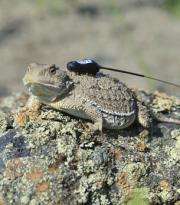Researcher wants to tip the scales for northern lizard

Armed with eyelash glue, a walking stick and a faithful horse, University of Alberta researcher Krista Fink is hoping to help Canada's most northern lizard get off the species-at-risk list.
With the help of a $68,000 grant from Parks Canada, Fink, under the supervision of renewable resources professor Scott Nielsen and adjunct professor Shelley Pruss, is spending two years exploring the barren grassland habitat of the greater short-horned lizard, a mouse-sized, scaly specimen that is found in parts of Alberta and Saskatchewan and could number as little as 2,500.
While the lizard is also found in Mexico and parts of the western United States, there is a concern that they could die out in Canada, so were listed as a species at risk in 2007 under the federal government's Species at Risk Act.
"Most people may not realize that we have lizards this far north, but the greater short-horned specimen is able to withstand our harsh winters because it hibernates," Fink said. The lizard, which resembles a miniature dinosaur, is also unique because, unlike most other species of its kind that hatch, it gives birth to live young.
Fink, a master's student in the Faculty of Agricultural, Life and Environmental Sciences, is swinging a leg over her horse, Buck, and taking to the remote barren hills of Grasslands National Park in Saskatchewan to observe the lizard in its natural habitat.
Aiming to find ways to preserve their delicate ecosystems, Fink has started videotaping the lizards and using eyelash glue to attach transmitters to their backs to track their movements. "This will help us better understand their habitat needs."
To find the animals, she'll also probe the ground with her walking stick, hoping to catch a glimpse of the creatures, which blend into their gray and brown surroundings to the point of invisibility.
"It helps me spot the lizards when they move," Fink said, then added: "I hope I don't hit any rattlesnakes in the process."
By recording their movements, Fink wants to find out where they are choosing to live, and why.
"This will help identify their critical habitat needs and document their population sizes to better manage their population recovery."
Fink and Nielsen hypothesize that energy development, road construction and certain livestock grazing practices could be possible threats to the lizards' habitat. Because they are living in such small, fragmented populations, they are especially vulnerable to any kind of change, Nielsen noted. "The smaller the population, the bigger the impact. To lose these lizards would be especially disturbing, because they are so rare in Canada."
At the end of the study, which began last summer, Fink hopes to have some recommendations for Parks Canada on how to protect and preserve home ground for the lizards, which have recently become a tourist attraction in the Grasslands National Park.
"They are quite charismatic," added Fink, who has gotten to know the lizards well over the course of her project. "Each lizard has a distinct expression; some look like they are frowning, others look as if they are grinning. It adds a lot of imagined personality to the species."
Provided by University of Alberta (news : web)

















